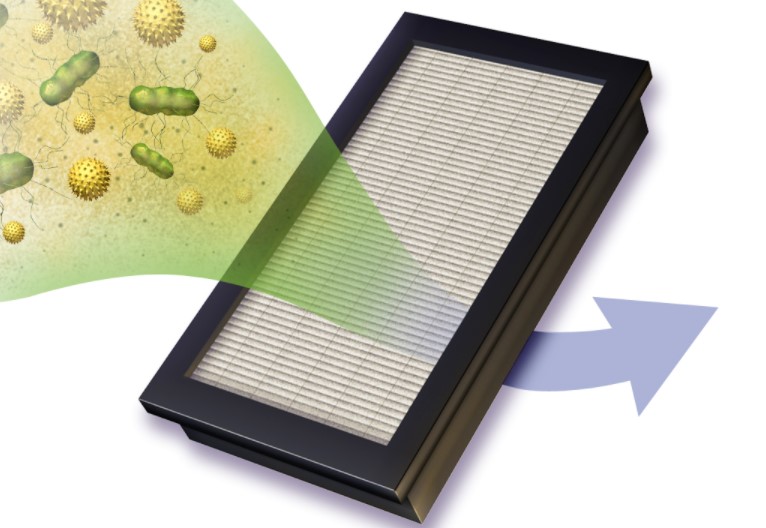High efficiency particulate arrestance HEPA

|
Contents |
[edit] Introduction
High efficiency particulate arrestance, or HEPA, is a method of air filtration incorporated into a specific type of pleated mechanical particulate absorbing air filter. Due to the mechanical nature of their operations, HEPA purifiers are effective in environments where medical conditions such as asthma or allergies may be prevalent.
[edit] HEPA parameters
To qualify as a HEPA filter, the device must remove 99.95% (EU standard) or 99.97% (ASME, US DOE) of dust, pollen, mould, bacteria and airborne particles with a size of 0.3 microns (µm) from the air that passes through it. However, the term is sometimes used to market products that may not comply with this HEPA standard.
This value is used for filter classification because it is close to the most penetrating particle size (MPPS) of approximately 0.2-0.3 μm (NASA). Particles that are larger or smaller than the MPPS are filtered more efficiently than the rated efficiency, although in some circumstances particles below the MPPS may act as nucleation sites and form particles close to the MPPS.
HEPA filters first became available in the 1950s, but their effectiveness was not technically rated until after the introduction of the minimum efficiency reporting value (MERV) rating system. MERV was developed in the 1980s by the American Society of Heating, Refrigerating and Air-Conditioning Engineers (ASHRAE).
For more information, see Minimum efficiency reporting value MERV.
Using a range from 1 to 20, the MERV rating system reflects the measurement of a filter’s arrestance - or its ability to remove dust from the air - relative to how many of a specific size dust particle (within the range of 0.3 to 10 µm) need to be removed to keep HVAC equipment clean. The higher the MERV rating, the better the filter is at trapping specific types of particles.
In January 2009, ASHRAE stopped recognising general air filters with MERV values based on ratings in the 17 to 20 range. This range is instead represented by HEPA and ultra low particulate air (ULPA) filters, which are capable of removing extremely high levels of dust particles as well as some viruses and other dangerous airborne particulates.
[edit] Proper care and operations of HEPA filters
Appropriate operating conditions are needed in order for HEPA filters to perform as designed. These parameters include velocity and direction of airflow, particle concentration, particle size distribution and appropriate temperature and humidity levels. Design factors, such as non-uniformity of filter pleats or improper filter installation, can also have an impact on the efficiency of these devices.
HEPA filters also need to be inspected and changed on a regular basis. The period between replacement may vary on the setting and the demands of the environment. If the filters are not maintained properly, they will no longer operate efficiently and may even have a negative impact on both the people and the equipment that they are meant to protect.
[edit] HEPA filters and COVID-19
Since COVID-19 is 50 to 200 nanometres in size, it is smaller than the MPPS of HEPA filters, and thus the filter should be able to remove it with at least the rated efficiency.
HEPA filters are not designed to kill viruses and bacteria, which can stay in the filter as long as they survive. This can be up to nine days for COVID-19 in certain conditions. However, COVID-19 survives best on hard surfaces and tends to die faster on soft, porous materials such as filter media.
[edit] Related articles on Designing Buildings
- Air filtration.
- Air filtration and clean indoor air quality standards.
- American Society of Heating and Air-conditioning Engineers.
- Arrestance.
- Building ventilation and COVID-19 transmission risk.
- Clean indoor air for healthy living - New air filter standards.
- Designing HVAC to resist harmful microorganisms.
- Indoor air quality.
- Minimum efficiency reporting value MERV.
Featured articles and news
The Building Safety Forum at the Installershow 2025
With speakers confirmed for 24 June as part of Building Safety Week.
The UK’s largest air pollution campaign.
Future Homes Standard, now includes solar, but what else?
Will the new standard, due to in the Autumn, go far enough in terms of performance ?
BSRIA Briefing: Cleaner Air, Better tomorrow
A look back at issues relating to inside and outside air quality, discussed during the BSRIA briefing in 2023.
Restoring Abbotsford's hothouse
Bringing the writer Walter Scott's garden to life.
Reflections on the spending review with CIAT.
Retired firefighter cycles world to raise Grenfell funds
Leaving on 14 June 2025 Stephen will raise money for youth and schools through the Grenfell Foundation.
Key points for construction at a glance with industry reactions.
Functionality, visibility and sustainability
The simpler approach to specification.
Architects, architecture, buildings, and inspiration in film
The close ties between makers and the movies, with our long list of suggested viewing.
SELECT three-point plan for action issued to MSPs
Call for Scottish regulation, green skills and recognition of electrotechnical industry as part of a manifesto for Scottish Parliamentary elections.
UCEM becomes the University of the Built Environment
Major milestone in its 106-year history, follows recent merger with London School of Architecture (LSE).
Professional practical experience for Architects in training
The long process to transform the nature of education and professional practical experience in the Architecture profession following recent reports.
A people-first approach to retrofit
Moving away from the destructive paradigm of fabric-first.
International Electrician Day, 10 June 2025
Celebrating the role of electrical engineers from André-Marie Amperè, today and for the future.
New guide for clients launched at Houses of Parliament
'There has never been a more important time for clients to step up and ...ask the right questions'
The impact of recycled slate tiles
Innovation across the decades.
EPC changes for existing buildings
Changes and their context as the new RdSAP methodology comes into use from 15 June.
























